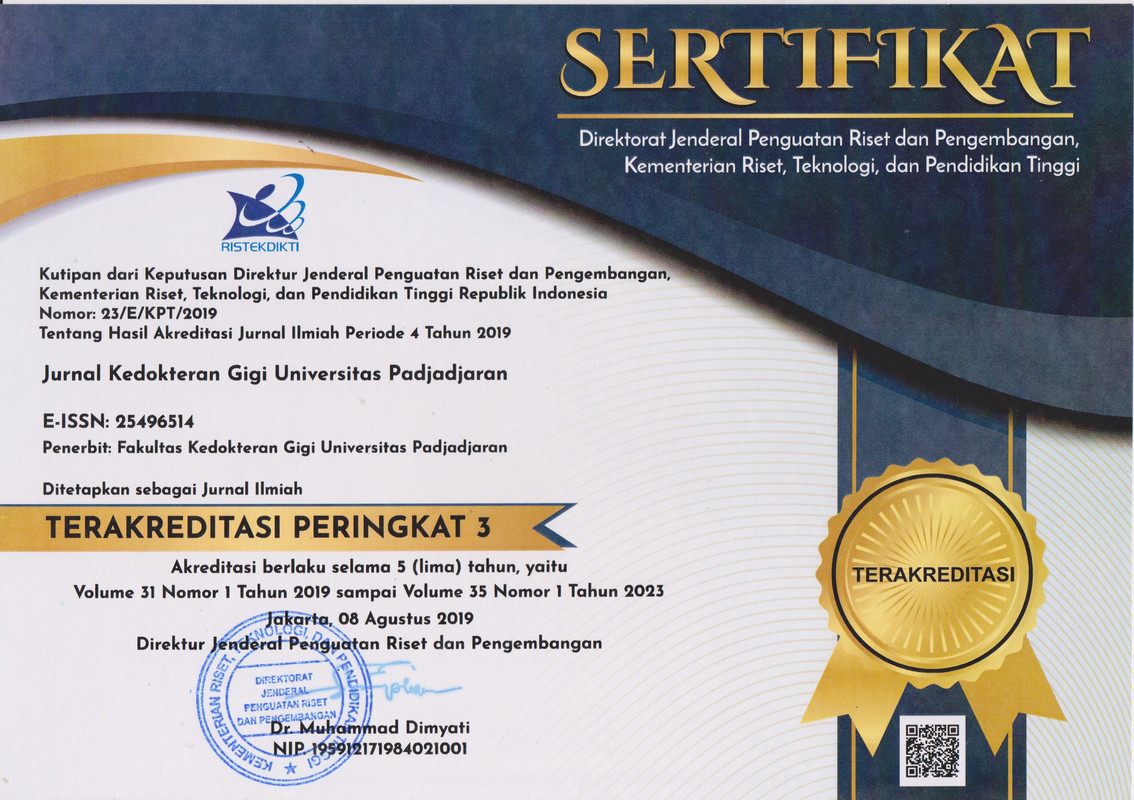Penegakan diagnosis dan tata laksana radiks entomolaris gigi molar kedua mandibula menggunakan CBCT dengan teknik SLOB: laporan kasus
Abstract
ABSTRAK
Pendahuluan: Disinfeksi sistem saluran akar dari mikroorganisme akan mempengaruhi tingkat keberhasilan perawatan endodontik. Saluran akar yang terlewatkan dapat menjadi penyebab kegagalan perawatan. Sehingga, klinisi harus mengetahui dan memahami variasi dari morfologi akar. Salah satu variasi morfologi akar dimana terdapat adanya akar tambahan di bagian distolingual. Tujuan laporan kasus memaparkan penegakan diagnosis dan tata laksana radiks entomolaris gigi molar kedua mandibula menggunakan CBCT dengan teknik SLOB. Laporan kasus: Perempuan, 27 tahun, datang ke RSGM-P Universitas Trisakti dengan keluhan sakit gigi pada sisi kiri rahang bawah. Pemeriksaan klinis, terlihat gigi 36 dengan kavitas yang besar, sedangkan gigi 37 tertutup tumpatan sementara. Pemeriksaan radiografi, terlihat gambaran radiolusensi melibatkan pulpa serta perubahan pada periapikal gigi 37. Gambaran kabur pada radiografi dari outline akar distal diduga adanya akar tambahan. Diagnosis nekrosis pulpa dengan periodontitis apikalis simtomatik. Saat pembuatan akses kavitas terlihat orifis saluran akar distal yang menjauh dari garis tengah imajiner sehingga diperlukan modifikasi akses kavitas menjadi trapezoidal. Perawatan saluran akar dilakukan pada gigi 37 dan direstorasi menggunakan indirek overlay. Pengetahuan variasi morfologi akar dapat menghindari terjadinya missed canal. Akses kavitas juga memiliki peran penting untuk menentukan lokasi akar tambahan dan letak orifis. Penggunaan magnifikasi dan alat ultrasonik sangat membantu dalam menentukan dan merawat gigi dengan radiks entomolaris. Rehabilitasi gigi dengan restorasi indirek akan memberikan keberhasilan jangka panjang. Simpulan: Diagnosis tepat, penatalaksanaan dan rehabilitasi gigi dengan akar ekstra yang baik, akan memberikan keberhasilan jangka panjang. Penggunaan CBCT atau radiografi konvensional dengan teknik SLOB dapat membantu mengidentifikasi radiks entomolaris dalam perawatan endodontik. Klinisi perlu mengetahui tahapan dan modifikasi yang dibutuhkan selama perawatan endodontik pada gigi dengan radiks entomolaris untuk menghindari kesalahan iatrogenik.
Kata kunci
radiks entomolaris, saluran akar, perawatan saluran akar, restorasi indirek, onlay
Diagnosis and Management of radix entomolaris in the mandibular second molar using CBCT with the SLOB technique: Case report
ABSTRACT
Introduction: Successful endodontic treatment depends on the removal of microorganisms from root canal systems. Missed canal can jeopardize the treatment's outcome. Therefore, clinicians should be aware and have a good understanding of the variations in root canal morphology. This case report aims to present the diagnosis and management of radix entomolaris in the mandibular second molar using CBCT with the SLOB technique.Case report: A 27-year-old female visited RSGM-P Universitas Trisakti with a complaint of pain in the left side of the jaw. Clinical examination showed that tooth no 36 with deep caries and no 37 filled with temporary restoration. On radiograph examination, radiolucency involves the pulp with periapical changes on tooth no 37 from. A Hazy image on the outline of distal root suggests extra roots. A diagnosis of pulp necrosis with apical periodontitis was made The distal root canal orifice is seen to be far from the fictitious midline at the time the cavity access is made, so it is required to adjust the cavity access to become trapezoidal. Root canal treatment was done and followed by prosthetic rehabilitation with indirect overlay. An accurate diagnosis of radix can avoid missed canal. Access cavity also plays a critical role to locate extra root and canal orifices. Magnification and ultrasonic can be helpful in locating and treating radix entomolaris. Rehabilitation of the tooth with indirect restorations will lead to the long-term success of the tooth. Conclusion: Accurate diagnosis, proper management and rehabilitation of the tooth with presence of extra root, will lead to the long-term success of the tooth. Radix entomolaris can be identified using CBCT or traditional radiography with the SLOB approach in endodontic therapy. To avoid iatrogenic errors, clinicians must understand the phases as well as modifications required for endodontic treatment of teeth with radix entomolaris.
Keywords
radix entomolaris, root canal , root canal treatment, indirect restoration, onlay
Keywords
Full Text:
PDFReferences
DAFTAR PUSTAKA
Peters OA, Arias A, Shabahang S. Cleaning and Shaping. Dalam: Berman LH, Hargreaves KM, editors. Endodontics: Principles and Practices. 6th ed. St. Louis: Elsevier; 2021. p. 305-7.
Gutmann JL, Fan B. Tooth Morphology and pulpal access cavities. Dalam: Berman LH, Hargreaves KM, editors. Cohen’s Pathways of the Pulp. 12th ed. St. Louis: Elsevier; 2020. p. 766-850.
Abrami S. The Radix Entomolaris: management of the distolingual root canal. G Ital Endod. 2016;30(2):120-123. DOI: 10.1016/j.gien.2016.09.007
Jaiswal S, Gupta S, Chhokar S, Bahuguna V. Endodontic Management of Radix Entomolaris in Mandibular Second Molar - A Case Report and Ex-Vivo Evaluation. 2015;8(2):68-71. DOI: 10.4103/ccd.ccd_821_17
Kuzekanani M, Walsh LJ, Haghani J, Kermani AZ. Radix entomolaris in the mandibular molar teeth of an iranian population. Int J Dent. 2017;2017:1-4. DOI:10.1155/2017/9364963
Vivekananda Pai AR, Colaco A, Jain R. Detection and endodontic management of radix entomolaris: Report of case series. Saudi Endod J. 2014;4(2):77. DOI:10.4103/1658-5984.132723
Rokni HA, Alimohammadi M, Hoshyari N, Charati JY, Ghaffari A. Evaluation of the Frequency and Anatomy of Radix Entomolaris and Paramolaris in Lower Molars by Cone Beam Computed Tomography (CBCT) in Northern Iran, 2020-2021: A Retrospective Study. Cureus. 2023 Oct 11;15(10):e46854. DOI: 10.7759/cureus.46854.
Harinkhere CK, Pandey SH, Patni PM, Jain P, Raghuwanshi S, Ali S, et al. Radix entomolaris and radix paramolaris in mandibular molars: a case series and literature review. Gen Dent. 2021;69(3):61-67. https://pubmed.ncbi.nlm.nih.gov/33908881/PMID: 33908881
Arora A, Arya A, Chauhan L, Thapak G. Radix Entomolaris: Case Report with Clinical Implication. Int J Clin Pediatr Dent. 2018;11(6):536-538. DOI:10.5005/jp-journals-10005-1572
López-Rosales E, Castelo-Baz P, De Moor R, Ruíz-Piñón M, Martín-Biedma B, Varela-Patiño P. Unusual root morphology in second mandibular molar with a radix entomolaris, and comparison between cone-beam computed tomography and digital periapical radiography: A case report. J Med Case Rep. 2015;9(1):1-6. DOI:10.1186/s13256-015-0681-x
Aung NM, Myint KK. Three-Rooted Permanent Mandibular First Molars: A Meta-Analysis of Prevalence. Testarelli L, ed. Int J Dent. 2022;2022:1-30. DOI:10.1155/2022/9411076
Shemesh A, Levin A, Katzenell V, et al. Prevalence of 3- and 4-rooted First and Second Mandibular Molars in the Israeli Population. J Endod. 2015;41(3):338-342. DOI:10.1016/j.joen.2014.11.006
Agarwal M, Trivedi H, Mathur M, Goel D, Mittal S. The radix entomolaris and radix paramolaris: an endodontic challenge. J Contemp Dent Pract. 2014 Jul 1;15(4):496-9. DOI: 10.5005/jp-journals-10024-1568.
Pedullà E, Lo Savio F, La Rosa GRM, et al. Cyclic fatigue resistance, torsional resistance, and metallurgical characteristics of M3 Rotary and M3 Pro Gold NiTi files. Restor Dent Endod. 2018;43(2). DOI:10.5395/rde.2018.43.e25
Polesel A. Restoration of the endodontically treated posterior tooth. G Ital Endod. 2014;28(1):2-16. DOI:10.1016/j.gien.2014.05.007
Atlas A, Grandini S, Martignoni M. Evidence-based treatment planning for the restoration of endodontically treated single teeth: importance of coronal seal, post vs no post, and indirect vs direct restoration. Quintessence Int. 2019;50(10):772-781. DOI:10.3290/j.qi.a43235
Shu X, Mai Q-Q, Blatz M, Price R, Wang X-D, Zhao K. Direct and indirect restorations for endodontically treated teeth: a systematic review and meta-analysis, IAAD 2017 Consensus Conference Paper. J Adhes Dent. 2018;20(3):183-194. DOI:10.3290/j.jad.a40762
Alleman DS, Nejad MA, Alleman CA. The protocols of biomimetic dentistry. Inside Dent. 2017. p. 13, 64–73
Kimble P, Stuhr S, McDonald N, Venugopalan A, Campos MS and Cavalcant B. Decision making in the restoration of endodontically treated teeth: Effect of Biomimetic Dentistry Training. Dent. J. 2023; 11(7): 159. DOI: 10.3390//dj11070159
Deliperi S, Alleman D, Rudo D. Stress-reduced direct composites for the restoration of structurally compromised teeth: fiber design according to the “wallpapering” technique. Operative Dentistry. 2017;42(3):233-43. DOI:10.2341/15-289-t
Morimoto S, Rebello de Sampaio FB, Braga MM, Sesma N, Ozcan M. Survival rate of resin and ceramic inlays, onlays, and overlays: A systematic review and Meta analysis. J Dent Res. 2016 Aug;95(9):985-94. DOI: 10.1177/0022034516652848
DOI: https://doi.org/10.24198/jkg.v36i1.48050
Refbacks
- There are currently no refbacks.
Copyright (c) 2024 Jurnal Kedokteran Gigi Universitas Padjadjaran
INDEXING & PARTNERSHIP

Jurnal Kedokteran Gigi Universitas Padjadjaran dilisensikan di bawah Creative Commons Attribution 4.0 International License






.png)

















